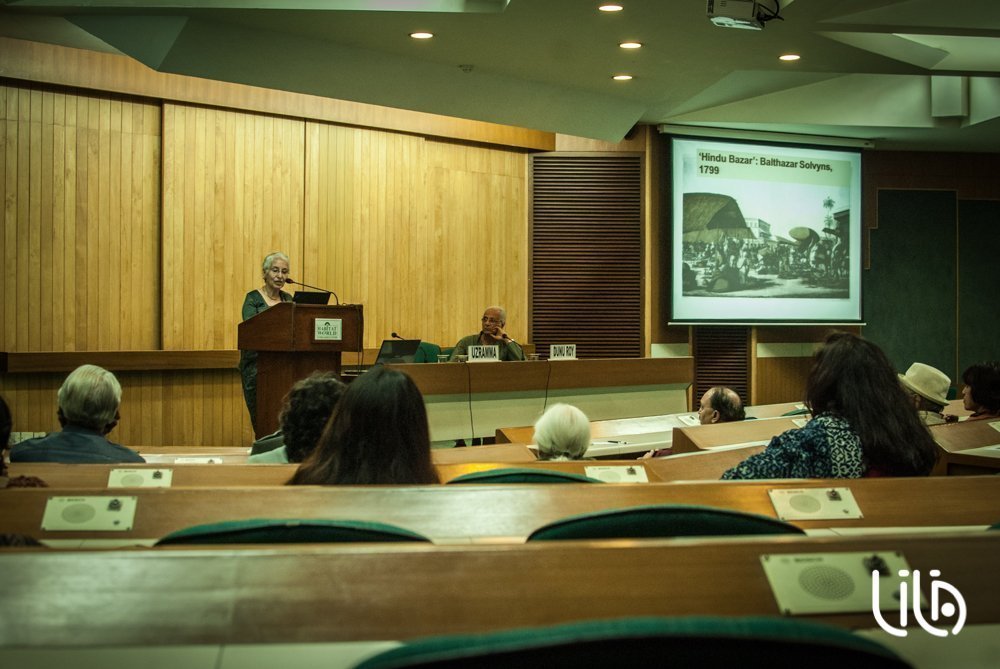
© LILA Foundation
 Uzramma, born a Hyderabadi, initiated the Dastkar Andhra Trust in 1995 to provide research and marketing services to the cotton handloom industry of Andhra Pradesh, and natural dyeing training to artisan groups. Retiring from Dastkar Andhra in 2005, Uzramma founded the Decentralized Cotton Yarn Trust and the Malkha Marketing Trust, of which she is currently the Director. Recognising the critical issue of yarn to the handloom industry, these organisations took up the challenge to make cotton yarn on a small scale in rural areas, bypassing some energy-intensive and damaging processes, and to market Malkha fabric woven on handlooms from this yarn.
Uzramma, born a Hyderabadi, initiated the Dastkar Andhra Trust in 1995 to provide research and marketing services to the cotton handloom industry of Andhra Pradesh, and natural dyeing training to artisan groups. Retiring from Dastkar Andhra in 2005, Uzramma founded the Decentralized Cotton Yarn Trust and the Malkha Marketing Trust, of which she is currently the Director. Recognising the critical issue of yarn to the handloom industry, these organisations took up the challenge to make cotton yarn on a small scale in rural areas, bypassing some energy-intensive and damaging processes, and to market Malkha fabric woven on handlooms from this yarn.
Dunu Roy, Director of the Hazards Centre, chaired the lecture and moderated the discussion. For the last three decades, he has been a major activist, agent and initiator around concerns of urbanism, development, technology, engineering and environment.
© LILA Foundation
 The lecture: The Power of the Handloom – India possesses a treasure house of skills and natural advantages in making cotton cloth on the handloom. This gives the country the huge advantage of a world-beating low-energy textile production process in the coming energy-stressed future. It can clothe its own people and increase its share of world textile trade – which from 50-60% in the mid-19th century has declined to less than 5% today. Cotton cultivation and yarn making should be integrated in the textile value chain to give a good living to farmers and weavers. The making of Malkha fabric is an initiative in this direction, based on years of practical and historical research.
The lecture: The Power of the Handloom – India possesses a treasure house of skills and natural advantages in making cotton cloth on the handloom. This gives the country the huge advantage of a world-beating low-energy textile production process in the coming energy-stressed future. It can clothe its own people and increase its share of world textile trade – which from 50-60% in the mid-19th century has declined to less than 5% today. Cotton cultivation and yarn making should be integrated in the textile value chain to give a good living to farmers and weavers. The making of Malkha fabric is an initiative in this direction, based on years of practical and historical research.
© LILA Foundation
The story starts as a fairytale. Once upon a time, a country produced enough cotton to clothe its large population, and much of the rest of the world. A tale in which emperors would go to any extent to acquire those refined, light and smooth clothes. And this fairy tale, is the story of cotton cloth in India. And a fairy tale it is, sadly, because the worldwide fame of the past has ironically turned into a leftover industry in its own land, overrun by the capital and energy demanding reign of the power looms. “The handloom is a low carbon production technology for the energy-stressed future,” textile activist Uzramma said, in the introduction of the eighth PRISM lecture of this year’s series… and yet, this industry, which employs nearly fifty million people in the country, is unrecognised, almost invisible, indebted and under-promoted today.
How could the fairy tale turn into a dark reality? The turning point is evident: the 18th century mechanisation shift. But its violence was not a necessity: mechanisation could have been decentralised and flexible in nature, akin to previous technological breakthroughs. In India, under the early capitalist empire of the British East India Company, it is a real paradigm shift that took place in and around the world of the cotton. From the early 1600s, the Company starting importing cotton to Great Britain and soon, flooding their local industry to death. New highways to profit open, and the plantations shift to North America. It affects economy so deeply that the price fluctuation of slaves and cotton become directly related. This cotton yarn, first item of mass production, is sold again in India, below the market price of locally produced threads.
The damage is done: centralised and internationally competitive corporations have started injecting the lethal solution in the veins of the traditional Indian industry. The American yarn is favoured as a less refined but stronger fibre, the only one able to resist the violent movements of the steel machines, made inexorable to ensure the wealth accumulation of their owners. But nature has its limits: American cotton struggles to survive in the soil and climate of India. Farmers are forced by economic pressures to grow a risky cotton. Thus starts another calamity, one of history’s largest socio-economic tragedy: the long thread of farmer suicides in the Indian sub-continent.
Behind the cloudy present, the past reminds us of the possibility of another future. In the early centuries of the Common Era, the Roman historian Pliny commented unambiguously on how India’s cotton had already started to travel through the world: “India is draining Rome of her gold.” Uzramma also presented another historical proof – a piece of cotton cloth of Indian origin, found in Egypt and dated between the 10th and the 14th century CE. It is simple, comfortable and affordable. India was by then renowned for ‘everyday weaving’. And finally, among tens of other evidences, the report of an Indian weekly market, in 1867, showing that 572 of the 1400 stalls were related to cotton, yarn and clothes. But all those proofs of vitality remain closed behind the doors of our past: today, no research focuses on the industry that could indeed clothe a population reaching 250 million in 1830.
How can this past return to a state of reality? “We need flexible yarn technologies for the multiple needs of India. We must free ourselves of the burden of a rigid, inflexible, energy-intensive yarn spinning technology.” Today, the mills live on bank support, in survival mode over a frightening debt of 2 Lakh Crore rupees. “The textile technology is viable only through debt financing and exploited workforces.” In a state of life support, the Indian textile industry attracts what is now known as ‘vulture investors’ – businessmen eager to drain the last pennies of dying industries. Multi-billionaire Wilbur Ross has expressed his interest in the Indian textile industry, and if he opts for a predictable shift of production to more cost-effective locations such as China or Vietnam, our times could indeed witness the gloomy spectacle of the end of India’s handloom. One possible response: developing small scale spinning technologies. “I must end with a plea,” concluded Uzramma. “A plea for alternative energies. For the establishment of small mills right next to the cotton fields. This, only, could change the predicted destiny of the Indian handloom.”
Dunu Roy chaired the discussion and opened the floor for numerous questions and remarks from the audience. Uzramma could elaborate on her initiatives with the Dastkar Andhra Trust, the Decentralized Cotton Yarn Trust and the Malkha Marketing Trust as possible alternatives for another approach to the cotton industry of present India.
Samuel Buchoul



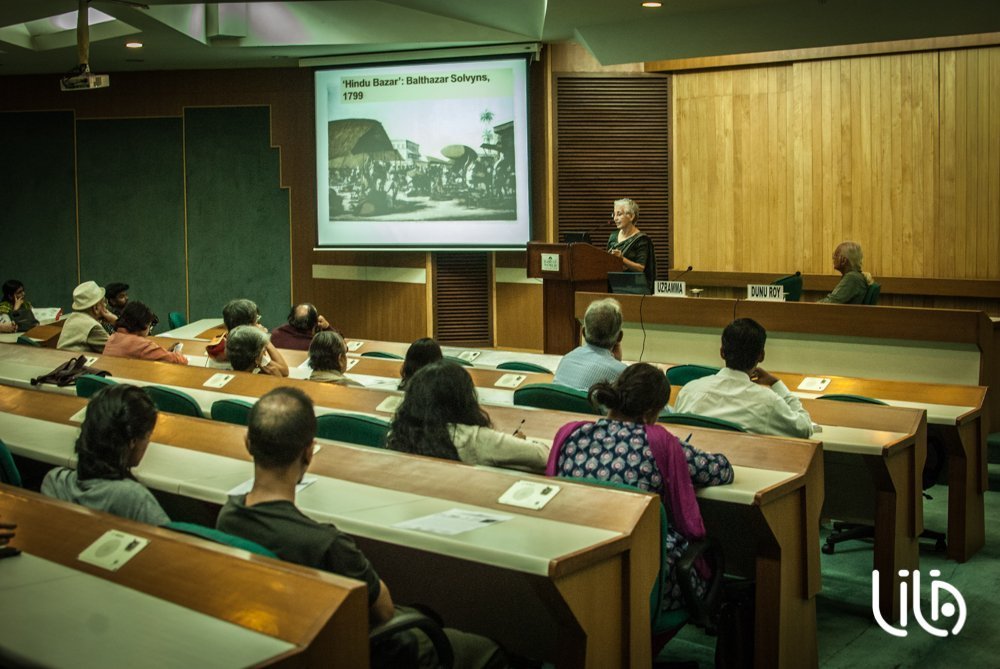


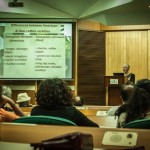










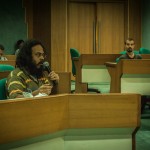
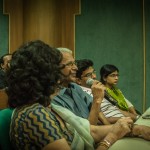



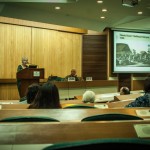



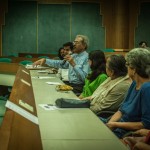





Sujata Madhok
This was truly interesting. But broadly people do know how the traditional weaving and handloom industry was destroyed by the British. What I would have liked to learn about was the alternatives conceived by Dastkar, the Cotton Yarn and Malkha Trusts. How viable are they? Can they be upscaled? Some of us in the cities love our handlooms and have the resources to buy handloom even if it is more expensive. But this small section cannot sustain the weavers and the cotton growers. More prachar is needed on the entire issue. Otherwise we will just be condemned as old fashioned, outdated, impractical people while the mass of Indians buy and wear polyester.
Satchin Joseph Koshy
Thank you for sharing this interesting observation. This recent piece by
Shiv Visvananthan echoes the spirit of what you are saying:
http://www.thehindu.com/opinion/op-ed/the-last-trustee-of-indigo/article6630582.ece?homepage=true